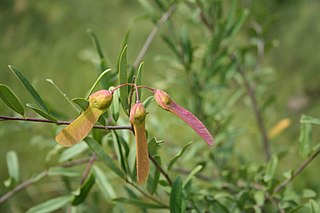
The Polygalaceae or the milkwort family are made up of flowering plants in the order Fabales. They have a near-cosmopolitan range, with about 21 genera and ca. 900 known species of herbs, shrubs and trees. Over half of the species are in one genus, Polygala, the milkworts.

Polygala is a large genus of flowering plants belonging to the family Polygalaceae. They are commonly known as milkworts or snakeroots. The genus is distributed widely throughout much of the world in temperate zones and the tropics. The genus name Polygala comes from the ancient Greek "much milk", as the plant was thought to increase milk yields in cattle.

Spergularia rubra, the red sandspurry or red sand-spurrey, is a plant species in the family Caryophyllaceae. It is native to Europe and Asia, and it is present on other continents, including North and South America and Australia, as an introduced species and in many areas a common weed. It grows in a wide variety of habitat types.
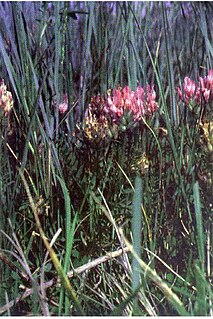
Astragalus agrestis is a species of milkvetch known by the common names purple milkvetch, purple loco, and field milkvetch. It is native to much of western and northern North America from most of Canada to the southwestern United States, as well as eastern Asia. It grows in vernally moist areas such as meadows, and is often found in sagebrush.

Rhinotropis acanthoclada, synonym Polygala acanthoclada, is a species of flowering plant in the milkwort family known by the common names desert polygala and thorn milkwort. It is native to the desert woodlands of the southwestern United States from Utah to the Mojave Desert. It is a small, bushy shrub spreading or growing erect and approaching one meter in maximum height. It is hairy in texture, the youngest twigs hairiest with a feltlike coat of short, whitish fibers. The lance-shaped or oval leaves are up to 2.5 centimeters long. Some of the twigs narrow to spines at the tips, especially in the inflorescences. The flowers are solitary or in clusters of up to 15. Each flower has five sepals, the lateral two white in color and spreading out like wings. The middle petal is keeled, with a flat tip protruding. The fruit is a capsule about half a centimeter long.
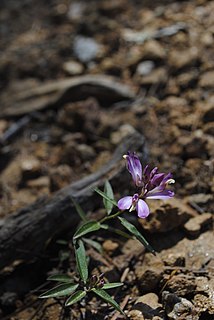
Rhinotropis californica, synonym Polygala californica, is a species of flowering plant in the milkwort family known by the common name California milkwort. It is native to southwestern Oregon and northern and central California, where it grows in the coastal mountain ranges in local habitat types such as chaparral and forest. It is a perennial herb producing spreading stems, generally decumbent in form, up to about 35 centimeters in maximum length, lined with narrow oval leaves each a few centimeter long. The upper inflorescences produce several open flowers, and there may be some closed, cleistogamous flowers lower on the plant. The open flowers have pink or white winglike lateral sepals with hairy edges. The petals are similar in color, the central one tipped with a white or yellow beak. The fruit is a flattened green capsule up to a centimeter long containing hairy seeds.

Rhinotropis cornuta, synonym Polygala cornuta, is a species of flowering plant in the milkwort family known by the common name Sierra milkwort. It is native to many of the mountain ranges of California and northern Baja California, where it grows in local habitat types such as chaparral and forest. It is a rhizomatous perennial herb or shrub known to exceed 2 meters in maximum height, spreading or growing erect. The leaves are linear, lance-shaped, or narrowly oval, up to 6.5 centimeters long, and widely spaced along the branches. The inflorescence is a short array of flowers varying in color from greenish or yellowish white to pink. Each has two winglike lateral sepals, and the keeled central petal is tipped with a short beak. The fruit is a brownish flattened capsule.
Rhinotropis heterorhyncha, synonym Polygala heterorhyncha, is a species of flowering plant in the milkwort family known by the common names beaked spiny polygala and notch-beaked milkwort. It is native to southern Nevada and it is known from a few occurrences just over the border in the Funeral Mountains of California above Death Valley. It is a resident of desert scrub habitat. This desert plant is a perennial herb or small shrub growing in small clumpy mats. The thin, branching, thorny-tipped stems are somewhat waxy in texture and sometimes slightly hairy. They are lined sparsely with small oval, dull-pointed leaves. The inflorescence bears a few flowers, each with a winglike pair of bright pink sepals and a yellow-tipped central petal. The fruit is a vein-streaked capsule.
Rhinotropis intermontana, synonym Polygala intermontana, is a species of flowering plant in the milkwort family known by the common name intermountain milkwort. It is native to the southwestern United States from Utah to northern Arizona and far eastern California, where it grows in desert scrub and woodland habitat. It is a small shrub growing erect or forming tangled, mats of thorny, highly branched stems. The stems are hairy in texture with white fibers. The sparse leaves are linear to oval in shape. The inflorescence bears one to seven flowers, each just a few millimeters in length. The flower has a winglike pair of greenish or whitish sepals and a keeled central petal.

Polygonum polygaloides is a North American species of flowering plants in the buckwheat family known by the common names milkwort knotweed and polygala knotweed. It is native to much of western North America, where it can be found in many types of moist habitat. It is a variable species, usually divided into a number of subspecies.
Streptanthus oliganthus is an uncommon species of flowering plant in the mustard family known by the common name Masonic Mountain jewelflower. It is native to western Nevada and eastern California, where it grows in the rocky hills east of the central Sierra Nevada. Its habitat includes forest, woodland, sagebrush, and mountain talus. It is a rhizomatous perennial herb producing a hairless, waxy, usually unbranched stem up to about 40 or 50 centimeters in maximum height. The basal leaves have lance-shaped, smooth-edged blades up to 10 centimeters long borne on fuzzy to rough-haired petioles. Leaves higher on the stem have shorter blades which may clasp the stem at their bases. Flowers occur at intervals along the upper stem. Each has a bell-shaped calyx of purple sepals no more than a centimeter long. The petals emerging from the tip are reddish purple or purple-tipped. The fruit is a smooth, flat, straight or slightly curved silique up to 8 to 10 centimeters long.
Streptanthus polygaloides is a species of flowering plant in the mustard family known by the common name milkwort jewelflower. It is endemic to the Sierra Nevada foothills of California, where it grows in woodlands and chaparral, generally on serpentine soils.
Frasera tubulosa is a species of flowering plant in the gentian family known by the common name Kern frasera.

Polygala lewtonii is a rare species of flowering plant in the milkwort family known by the common name Lewton's polygala, or Lewton's milkwort. It is endemic to Florida in the United States, where it is limited to the central ridge of the peninsula. There are about 49 occurrences of the plant remaining. Most occurrences contain very few plants. The species is threatened by the loss and degradation of its habitat. This is a federally listed endangered species of the United States.
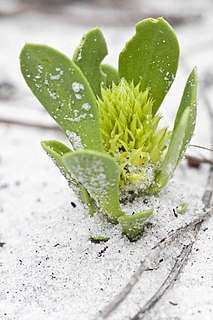
Polygala smallii is a rare species of flowering plant in the milkwort family known by the common name tiny polygala, or tiny milkwort. It is endemic to Florida in the United States, where it is limited to the southeastern coast of the peninsula. The plant is now only known from eight sites, with most individuals located on one site in Miami-Dade County. The species is threatened by the loss of its habitat. This is a federally listed endangered species of the United States.
Agave phillipsiana is a rare species of flowering plant in the asparagus family known by the common names Grand Canyon century plant and Phillips agave. It is endemic to Arizona in the United States, where it lives only in Grand Canyon National Park.
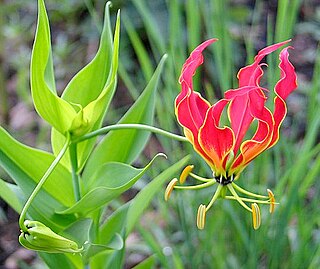
Gloriosa superba is a species of flowering plant in the family Colchicaceae. Common names include flame lily, climbing lily, creeping lily, glory lily, gloriosa lily, tiger claw, and fire lily.

Polygala senega is a species of flowering plant in the milkwort family, Polygalaceae. It is native to North America, where it is distributed in southern Canada and the central and eastern United States. Its common names include Seneca snakeroot, senega snakeroot, senegaroot, rattlesnake root, and mountain flax. Its species name honors the Seneca people, a Native American group who used the plant to treat snakebite.
Polygala africana is a species of flowering plant in the milkwort family (Polygalaceae). It was first described in 1893.

Rhinotropis is a small genus in the family Polygalaceae. It was separated as a genus from Polygala by J. Richard Abbott in 2011. It is native to the south and west of the United States and to Mexico.











